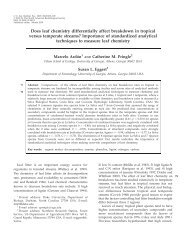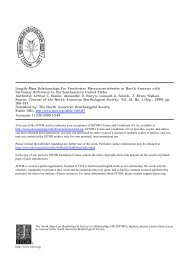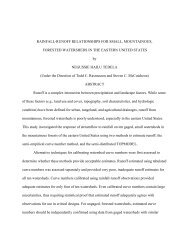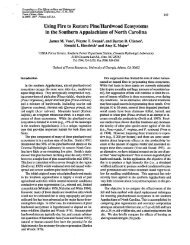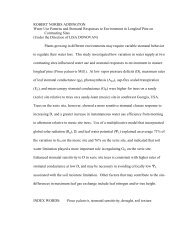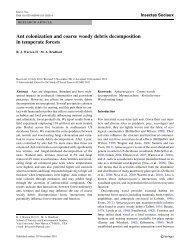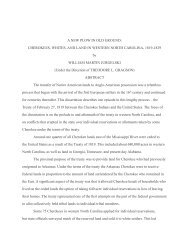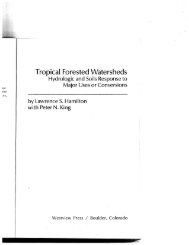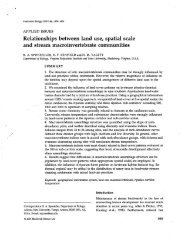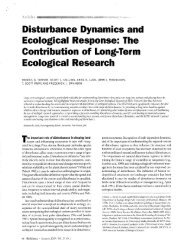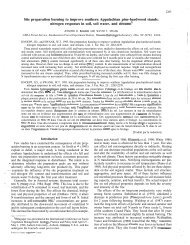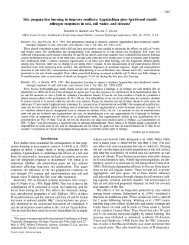biology join - Coweeta LTER - University of Georgia
biology join - Coweeta LTER - University of Georgia
biology join - Coweeta LTER - University of Georgia
You also want an ePaper? Increase the reach of your titles
YUMPU automatically turns print PDFs into web optimized ePapers that Google loves.
Articles<br />
(Herbert et al. 1999). Multiple-resource-limitation theory, in<br />
turn, has influenced the development <strong>of</strong> Earth-system models<br />
that explore the implications <strong>of</strong> N constraints on C cycling at<br />
a global scale (e.g., Gerber et al. 2010). Given the number and<br />
diversity <strong>of</strong> long-term experiments in the <strong>LTER</strong> Network, the<br />
opportunity certainly exists for additional theory and model<br />
development capable <strong>of</strong> linking a broad array <strong>of</strong> patterns and<br />
processes across temporal and spatial scales.<br />
There are broader practical outcomes <strong>of</strong> many long-term<br />
experiments when they influence the design <strong>of</strong> policy and<br />
management strategies. For example, the litter-exclusion<br />
experiment at the CWT site (figure 3) clearly demonstrated<br />
the importance <strong>of</strong> tree-leaf litter to the organisms living in<br />
headwater streams (Wallace et al. 1997). The importance<br />
<strong>of</strong> maintaining the integrity <strong>of</strong> headwater streams has been<br />
used as an argument against mountaintop mining practices<br />
in the central Appalachian region (Meyer and Wallace 2001)<br />
and cited in court cases (e.g., P. C. Chambers, US District<br />
Judge, Memorandum Opinion and Order on Civil Action<br />
No. 3:05-0784 in the Huntington Division <strong>of</strong> the US District<br />
Court <strong>of</strong> the Southern District <strong>of</strong> West Virginia, 23 March<br />
2007). Experimental demonstration <strong>of</strong> the dramatic impacts<br />
<strong>of</strong> deforestation on soil and surface-water chemistry at the<br />
HBR site (Bormann et al. 1974) raised awareness <strong>of</strong> the<br />
consequences <strong>of</strong> intensive forest harvest for environmental<br />
quality and influenced the development <strong>of</strong> best management<br />
practices for these forests. Simulations <strong>of</strong> hurricanes and<br />
mortality resulting from pests and pathogens demonstrated<br />
that the ecosystem consequences <strong>of</strong> salvage and restoration<br />
management <strong>of</strong> forests—both post-windstorm and in<br />
advance <strong>of</strong> insect infestation or disease—are <strong>of</strong>ten much<br />
greater than the impacts <strong>of</strong> the disturbances themselves and<br />
led to the argument that leaving forests alone is <strong>of</strong>ten a viable<br />
management alternative from an ecological perspective<br />
(Foster and Orwig 2006). Finally, the results from long-term<br />
experiments, coupled with gradient studies, field observations,<br />
and data from monitoring networks, have been used<br />
to estimate the critical loads <strong>of</strong> N for freshwater and terrestrial<br />
ecosystems <strong>of</strong> the United States (Pardo et al. 2011).<br />
Long-term experiments can provide a unique opportunity<br />
to directly evaluate the consequences <strong>of</strong> policy changes<br />
using an adaptive-management approach. In adaptivemanagement<br />
experiments, the researcher attempts to learn<br />
about managed systems by experimentally changing policy<br />
and assessing the outcomes on the appropriate time scale.<br />
At the NTL site, several policies were enacted as part <strong>of</strong> a<br />
long-term experiment designed to reduce P inputs and to<br />
control algal blooms in Lake Mendota, Wisconsin. Initial<br />
changes to land-use practices revealed little effect <strong>of</strong> management<br />
on the P inputs to the lake, possibly because <strong>of</strong> resuspension<br />
<strong>of</strong> P stored in sediments. Subsequent manipulation<br />
<strong>of</strong> the Lake Mendota food web to create a trophic cascade<br />
was more effective in reducing algal blooms, especially when<br />
they were accompanied by fishing-regulation changes and<br />
additional land-use practices implemented in the 1990s and<br />
2000s (Carpenter et al. 2006).<br />
Future policy can also be informed by results from<br />
long-term experiments. Work at the KBS site suggests<br />
that agricultural nitrous oxide (N 2 O) emissions (figure 3)<br />
increase exponentially with increasing rates <strong>of</strong> N fertilizer<br />
use, after the rates exceed the N-uptake capacity <strong>of</strong> the crop.<br />
In intensive agricultural systems, application <strong>of</strong> N in excess<br />
<strong>of</strong> plant needs is rather common, because fertilizer is inexpensive<br />
relative to commodity prices, and producers tend to<br />
hedge against the risk <strong>of</strong> insufficient N in order to achieve<br />
maximum yields. Using the concept <strong>of</strong> maximum return<br />
to N, Millar and colleagues (2010) developed a transparent<br />
N 2 O-reduction protocol suitable for incentivizing N 2 O<br />
reductions without affecting crop yields. They estimated<br />
that if the protocol were widely adopted as a part <strong>of</strong> future C<br />
cap-and-trade markets, the protocol could reduce N 2 O from<br />
fertilized row-crop agriculture by more than 50%.<br />
Long-term experiments as platforms for new and unplanned<br />
research. Because <strong>of</strong> their multiyear nature, long-term<br />
experiments can serve as platforms for research that goes<br />
well beyond the goals originally envisioned. As a result, they<br />
provide opportunities for novel studies that take advantage<br />
<strong>of</strong> imposed treatments, as well as for more detailed<br />
process-level studies to uncover mechanisms behind longterm<br />
patterns. For example, the soil-warming studies at the<br />
HFR site have become a platform for new studies <strong>of</strong> soil<br />
N; the consequences <strong>of</strong> garlic mustard invasion, an exotic<br />
species that inhibits mycorrhizae and the growth <strong>of</strong> some<br />
tree seedlings; and for microbial studies <strong>of</strong> the mechanisms<br />
responsible for the pattern <strong>of</strong> increased heterotrophic soil<br />
respiration followed by a diminishing response to warming<br />
(Bradford et al. 2008). This latter research showed that the<br />
apparent acclimation <strong>of</strong> soil respiration at the ecosystem<br />
scale results from the combined effects <strong>of</strong> reductions in soil<br />
C pools and microbial biomass and changes in the thermal<br />
response <strong>of</strong> microbial respiration. Mass-specific respiration<br />
rates were lower when seasonal temperatures were higher,<br />
which suggests that rate reductions under experimental<br />
warming probably occurred through temperature-induced<br />
changes in the microbial community.<br />
The long-term nutrient-addition studies that were conducted<br />
at multiple <strong>LTER</strong> sites to understand the role <strong>of</strong> N<br />
limitation, as well as to test ecosystem response to enhanced N<br />
deposition, have similarly provided a rich template for more<br />
short-term mechanistic studies. At the NWT site, for example,<br />
these studies have identified the importance <strong>of</strong> plant species<br />
traits in affecting community change (Suding et al. 2006)<br />
and demonstrated how plant–microbial feedbacks influence<br />
species coexistence (Ashton et al. 2008). Experiments initially<br />
designed to study vegetation change have been used to provide<br />
important insights as to how increased N availability can<br />
affect soil C storage (Neff et al. 2002).<br />
Long-term experiments are increasingly serving as platforms<br />
for ecological metagenomics studies. At the SEV site,<br />
for example, microbial ecologists are examining the metagenomic<br />
responses <strong>of</strong> rhizosphere microbes in a fully crossed<br />
386 BioScience • April 2012 / Vol. 62 No. 4 www.biosciencemag.org



